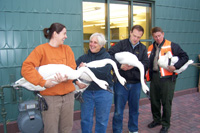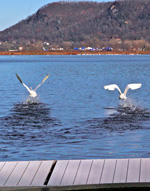How’s
the Weather Look?
Now travelers
on the Upper Mississippi River with web
access can easily check the weather in
rivertowns. Click here for a map
of the river from the Twin Cities to
Muscatine, Iowa. Click on any of the cities to open
a National Weather Service forecast for
that city.
River Adventurers
Diamond Bluff, Wis. — After floating down the St. Croix River
and into the Mississippi as far as Diamond Bluff last October,
a 51-year-old woman’s inflatable raft got punctured, and
she was stranded in a mess of floating
logs and debris for three days, until a Hager City, Wis., fisherman
found her.
The fisherman heard screams, boated
over to investigate and was startled when a head popped up from
under a blue tarp.
“I thought I was kind of
in ‘The Twilight Zone’ there
for a bit,” he recalled, in a story in the Pierce County
Herald (10-17-07). He took her to Diamond
Bluff and called 911. An emergency crew
arrived and found her in stable condition,
just cold and hungry.
She was dressed in
what the fisherman described as an evening
gown, and had only a blue tarp for protection,
a few berries to eat and a butane lighter for heat.
“She was
happy to get off the river,” said the fisherman,
Rob Iberg.
She’d spent a month floating downriver, stopping to work
at Prescott, Wis., for a while. The Coast
Guard had checked on her occasionally along
the way.
Farther downriver, in Vicksburg,
Miss., the Coast Guard stopped a raft,
saying it was unsuitable for one of the most dangerous
stretches of the Mississippi. The raft’s
only power came from a paddle turned by
two stationary bicycles. Three adventurers — Laura Mattingly,
Libby Hendon and James Burkart — had already peddled 1,000
miles down the Missouri and Mississippi rivers and were headed
to New Orleans. They agreed to install
an outboard motor to help them change course
more quickly. (WDSU New Orleans online, 10-22-07)

Volunteers hold the once-lost tundra
swans at the National Eagle Center
before their release back into the
river. |
Swan
Rescue
Wabasha,
Minn. — Five tundra swans,
migrating through the river valley
last November, apparently got lost
in the fog and came down in the woods
near Hammond, Minn., 30 miles from
the river.
Hunters
found four birds weak but alive,
and a fifth that had been killed
by a predator. They called a local
wildlife officer, who took the birds
to the nearby National Eagle Center.
The Eagle Center found no obvious
injuries, but delivered them to the
Wildlife Rehab Center in Roseville,
Minn., just to be sure.
After
a week of observation and good feeding,
the swans were released near Wabasha.
They swam around for a few minutes,
calling out to about 500 other swans
near the Peterson Lake area across
the river, before flying off to join
them. |

Swans fly off to resume their migration.(The
white specks across the river are
more swans. Click for a closer look.) |
Iowa Fish Advisory
Bellevue, Iowa — The
Iowa Department of Natural Resources has issued its first Mississippi
River fish advisory. The agency warned against eating more than
one meal per week or four per month of predator fish such as walleye,
sauger, bass and northern pike caught in Pool 12 (from Dubuque
to Bellevue, Iowa) in the Mississippi River.
Tests showed these fish to be high in mercury.
Exposure to even small amounts over a long
period can damage brain, kidneys, lungs and developing fetuses.
No single source of mercury is suspected.
Industrial pollution from coal-burning
power plants is a prime source, but mercury also occurs naturally.
Climate Change Events
Minneapolis — Climate
change is the subject of two upcoming National
Park Service programs in the Twin Cities.
On January
17, 2008, Jeffrey
Corney from the University of Minnesota’s Cedar Creek Ecosystem
Science Reserve will talk about potential
changes in Minnesota and the models that
predict them. The program starts at 7 p.m.
at the Minnesota Valley National Wildlife
Refuge Visitor Center.
On March
13, 2008, presenters will discuss
resource conservation programs that emerged
during the Depression and World War II,
and how people can support a new national
priority of conservation in response
to the threat of climate change. The
program starts at 7 p.m. at the Mill
City Museum.
Registration is requested.
Call the Mississippi River Visitor Center
at 651-293-0200. For directions or more information, see the
Mississippi
National River & Recreation
Area website.
Clean River Manual
St. Paul — A
manual to help developers, planners and
others improve Mississippi River water quality was created by the
St. Paul Riverfront Corp. with a grant from the McKnight Foundation.
“Water
Quality Manual: Improving the Water Quality
of the Mississippi River in St. Paul,” applies to cities
up and down the river. It addresses water-quality
issues, such as rain barrels, permeable
paving and native landscaping, techniques that filter pollutants
and keep them out of streams and rivers. The manual addresses a
key challenge of water-quality advocates, scaling such techniques
up to neighborhoods and cities, noted Steve Wise, natural resources
program manager for Center for Neighborhood Technology in Chicago.
“Nuts-and-bolts” is
a good way to describe the half-inch-thick
manual: Its unusual binding is a single bolt, allowing users to
take the document apart and hand around its card-like 4-by-7-inch
pages.
Manuals are available from the
St. Paul Riverfront
Corp. at 651-293-6860. |

